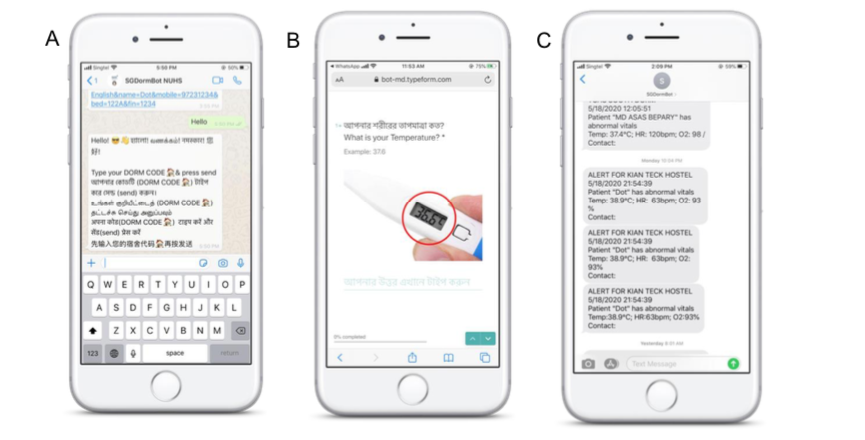Earlier this month, the National University Health System (NUHS) of Singapore partnered with a startup called Bot MD to launch SGDormBot, the first AI-powered bot developed for clinicians who are caring for COVID-19 patients, enabling real-time monitoring and telehealth intervention. SGDormBot is currently being used by 1,000 migrant workers residing in six dormitories under the medical management of NUHS.
“The idea behind SGDormBot started when I was approached by two doctors—Dr. Stephanie Ko and Dr. Jen Wei Ying—who had an idea for digitizing the collection of vital signs for the COVID-19-positive patients under their care,” Bot MD co-founder and CEO Dorothea Koh told KrASIA in a recent interview. When Dr. Ko was volunteering to manage treatment for COVID-19 patients in the dormitories, she saw how health information is recorded on paper, so keeping track of that information, and aggregating it, was a challenge for her. It was also difficult for many doctors to communicate with the migrant workers due to language barriers, said Koh.
“In addition, there was limited healthcare manpower deployed to the dormitories. All of them are volunteers and they are usually only available during office hours. Therefore, it is challenging to monitor the patients during the acute phase of their illness if their condition deteriorated. We wanted to build a clinical tool that would enable remote monitoring of these patients by volunteer doctors, and one which would be intuitive and widely accessible so that patients could self-report their vitals without needing too much additional training,” Koh explained.

For migrants living in the six dorms where SGDormBot is used, testing positive for COVID-19 means they will first be prompted by NUHS medical personnel to use the bot, which is operated through a WhatsApp business account, making it easy for them to set communications in their preferred language. A few doctors keep up with conditions in each dorm, and they receive alerts through SGDormBot whenever someone logs vitals from thermometers and oxygen monitors that suggest their condition is worsening. This functions as a flag that calls for medical intervention, which starts with a WhatsApp video call, and may escalate to a hospital visit for an in-person review.
Koh said the pilot for SGDormBot started in late April, and the project has recorded 90% compliance for two reports per day by users. To keep the project going, the Temasek Foundation has given the team behind SGDormBot a grant to improve its functionality.
Providing an AI assistant for doctors around the world
Bot MD was launched in June 2018 by Dorothea Koh and Yanchuan Sim, who serve as the firm’s CEO and CTO, respectively. Its platform is an AI clinical assistant for doctors and frontline medical workers that can be trained on hospital-specific content to provide instant answers to clinical questions, covering topics ranging from hospital protocols, medical calculators, call roster schedules, and drug formularies. Before Bot MD’s existence, Koh said, doctors would often need to call a hospital operator to ask for that information or log in to the hospital’s intranet. Being able to access these items via a smartphone is more convenient.
“Think of us like a Google Assistant or a Siri, but for healthcare. Our AI can be embedded into any website, mobile application, or even used to power consumer messaging platforms like Facebook Messenger, WhatsApp, Telegram, and so forth,” she said.
Read this: Do health apps and telemedicine live up to the hype?
The natural language processing chat engine that powers Bot MD was developed completely in-house. “The biggest value of building this from scratch is that it allows us to build medical chatbots ten times faster than using anything off the shelf.”
According to Koh, Bot MD has been adopted by more than 13,000 doctors in 60 countries across the globe, including emerging markets like Indonesia, the Philippines, Venezuela, and Nigeria. “We have been growing pretty rapidly and expanding into patient-facing use cases, like with SGDormBot, which has been wonderful to see. At the moment we have many customers ranging from public hospitals, to private hospital chains, and even Fortune 500 companies within the healthcare industry.”
The startup entered Y Combinator in 2018 and has raised USD 1.6 million in investments so far. Bot MD offers a freemium subscription model. Individual doctors can download the platform for free to access drug, guidelines, as well as information about less common diseases. Meanwhile, the company charges a fee for institution partners to integrate their medical or hospital content. It also charges monthly fees for each person who utilizes the bot on messaging platforms. Koh is optimistic that the company will hit profitability this year.
Based on data generated from SGDormBot, Koh believes that AI clinical assistants have the ability to empower both doctors and patients. “Our experience in launching SGDormBot has shown us that what we have created has tremendous potential to be expanded into other areas of clinical and home-based monitoring, so we are excited about this,” Koh said.
As the COVID-19 pandemic spreads around the world, more medical professionals are realizing how digital health services can play a crucial role in streamlining the industry. Koh believes this will encourage new developments within the sector, and may allow companies like Bot MD to grow and serve more doctors and hospitals, keeping their actions in line with the company’s mission to “empower doctors around the world.”
This article is part of KrASIA’s “Startup Stories” series, where the writers of KrASIA speak with founders of tech companies in South and Southeast Asia.

